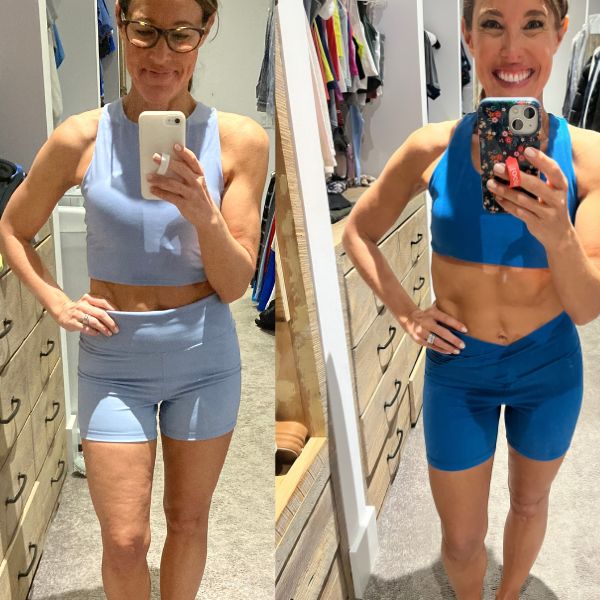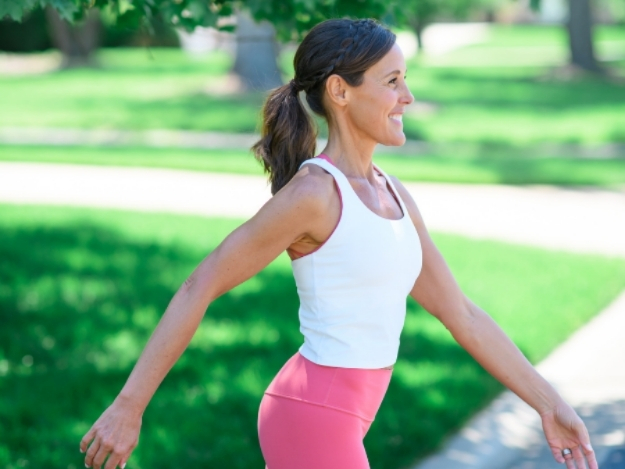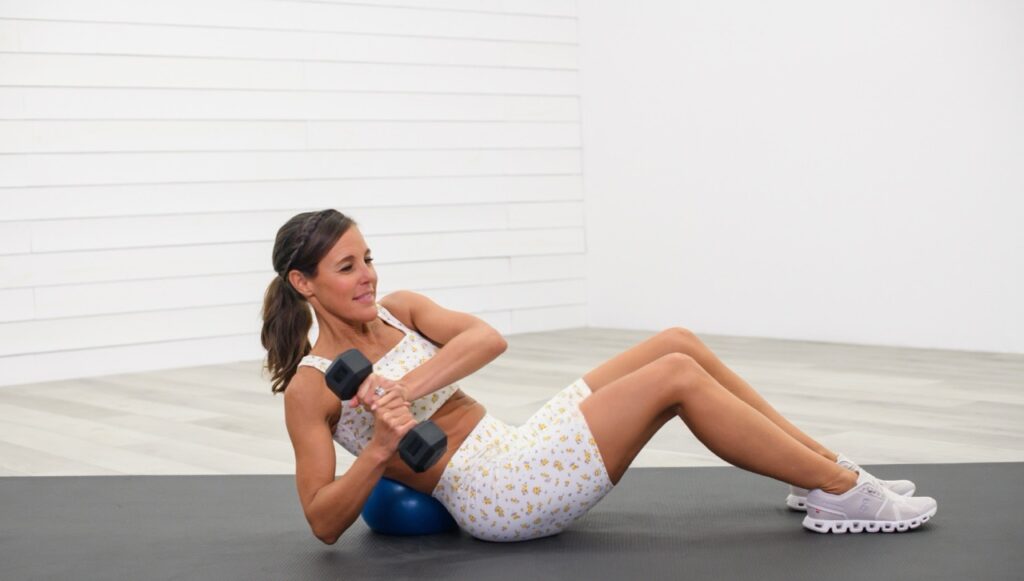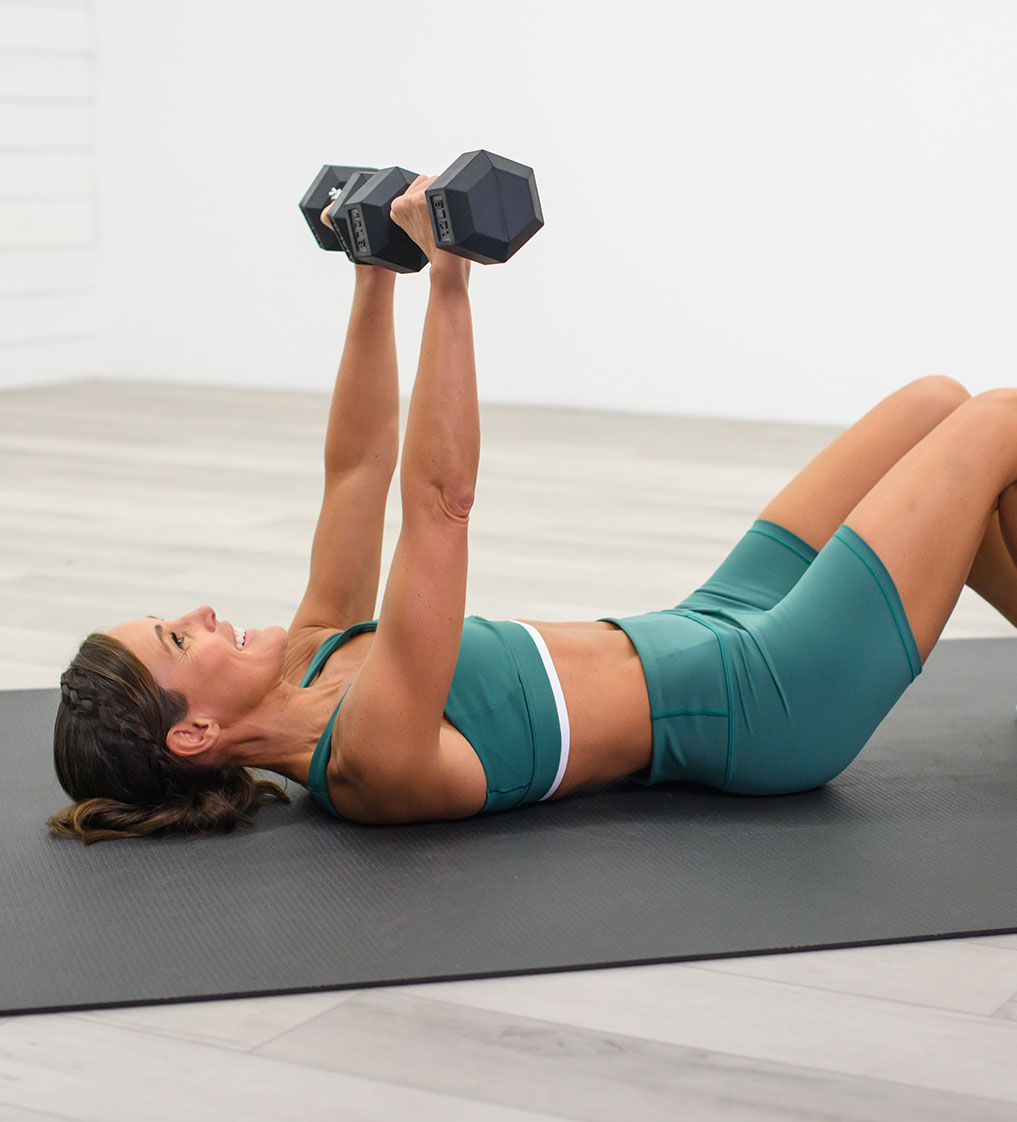
Lindsay Brin, Exercise Science
For years I chased endless cardio workouts, thinking that being gassed meant I’d had a “good” workout. Instead, it left me drained, inflamed, and moving in the wrong direction. When I turned 40, I realized that 80% of what I knew didn’t account for the hormonal and metabolic changes.
Which sent me down a five-year rabbit hole of research. Working with over 2,000 focus groups made it clear that the way we train in our 40s and beyond has to be different from what worked in our 30s.
I knew there had to be a better way—for me, and for the women I serve.
The photo at the top tells the story. Both were taken just three weeks apart, right after I turned 40. On the left: inflammation, fatigue, and cellulite. On the right: less inflammation, smoother skin, visible fat loss, and most importantly energy. I wasn’t exhausted anymore, my digestion improved, and for the first time in years, I felt good again. In those three weeks, I lost 7.5” and saw a big difference in my legs and neck.
So what changed? In just three weeks, here’s exactly what I did differently:
But why? Why did less do more? Was it turning 40? Overtraining? Central fatigue? Hormones?
Now at 45, I feel better than ever. Perimenopause reshaped the way I look at Exercise Science—and this approach works for me and for the thousands of women I serve.

Years of high intensity cardio spiked my cortisol and left me inflamed. No matter how hard I pushed, the results weren’t coming. Once I swapped in 30-minute daily walks, my body finally responded.
Walking at a steady, moderate pace lowers stress hormones, supports fat loss, and energizes rather than depletes. It also activates the parasympathetic nervous system — the “rest and digest” side — which is especially important in perimenopause when stress already runs high.
I used to check off my workout and then sit behind my desk the rest of the day. But fitness isn’t just what happens in 30 minutes, it’s what happens in the other 23.5 hours. Once I added a pedometer, I realized how little I was moving outside of workouts.
Adding NEAT (non-exercise activity thermogenesis) changed everything. Taking the stairs, pacing on calls, walks with my husband, or laps around the soccer park… it all added up. NEAT kept my metabolism humming and gave me consistent energy.
This was the missing link. Until my stress came down, nothing worked. At 40, my nervous system was stuck in “fight or flight.” Every hard workout piled more stress on top of stress, leaving me burned out.
The nervous system and musculoskeletal system work hand in hand. Muscles can recover in a day or two, but the nervous system often lags behind — especially in perimenopause. That’s why recovery matters just as much as the workouts themselves.
High stress workouts raise cortisol and adrenaline, which is fine in moderation, but without recovery it hurts more than it helps. Chronic SNS (fight/flight) activation raises cortisol, disrupts sleep, and blunts training results.
Once I changed my workouts, my body stopped fighting me. My hormones and energy finally lined up.
Not only did I lower my stress with my workouts, I got serious about sleep. I didn’t want to feel wired and tired all the time! Giving myself permission to rest, going to bed earlier, and setting boundaries around recovery completely changed how my body responded.
I used to fear that strength training would make me bulky. At 5’1”, the last thing I wanted was to feel bigger. But what actually happened was the opposite. It made me leaner, stronger, and healthier than ever. Just three structured lifting sessions each week transformed my metabolism, improved my bone density, and gave me visible muscle tone without the bulk I once dreaded.
The key? Good exercise selection and smart programming. Strength training isn’t about tossing weights around or chasing exhaustion. It’s about intentional, progressive lifting that challenges your muscles just enough to adapt. With the right movements, you get toned, not bulky. This is where I saw the biggest transformation, and it’s the foundation of what I teach to today.
I didn’t eat less. I actually eat more now than I did in my 20s. But the quality changed. More whole foods, more protein and fewer processed foods gave me steady energy, improved digestion, and healthier skin.
It’s not about perfection. I aim for 80% whole foods and 20% flexibility. That balance has kept me consistent for years.

Back then, I thought exhaustion meant progress. It wasn’t effort I was missing—it was alignment. By walking, adding NEAT, lowering stress, prioritizing sleep, lifting weights, and fueling smarter, I gave my body what it truly needed in perimenopause. Less fight, more flow.
This isn’t just my story. In focus groups of over 2,000 women, 85% saw positive changes using this approach. It’s science-informed, sustainable, and kind to your nervous system.
Why my workouts are different: they’re built for women in perimenopause: periodized strength, smart cardio (hello, walks), nervous-system-aware recovery, and realistic nutrition. Not punishment. Not burnout. A plan that works with your body, not against it.
Ready to feel the difference? Start the plan designed for your 40s and beyond. Join the free trial and follow the 3x/week strength + daily walking schedule. Two weeks from now, you’ll never want to go back to the old way.
